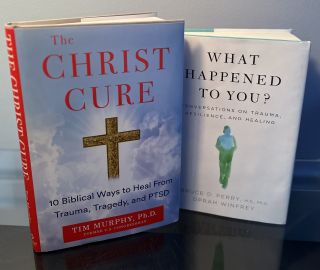Trauma
Healing Pathways From Childhood and Adult Trauma
Two books show how to emerge accomplished, confident, and renewed.
Posted May 22, 2023 Reviewed by Michelle Quirk
Key points
- Trauma is sometimes self-inflicted or the result of risks, but mostly random and beyond our control.
- Destructive behavior and relationships can perpetuate a reoccurring cycle.
- Connection and relationship strength can counterbalance adversity and aid in healing and recovery.
“Trauma is everywhere,” writes Tim Murphy, Ph.D. “It may be a life-threatening incident or an overwhelming emotional crisis. It may be directed at you, or you may happen to be a witness. It can be a single, intense event or prolonged stress lasting months or years.”
Dr. Murphy, a psychologist and mental health advocate, reports that 70 percent of American adults have encountered trauma.
It’s estimated that childhood adversity plays a major role in 45 percent of all childhood mental health disorders and 30 percent among adults, according to Bruce D. Perry, M.D., Ph.D.
There is much hope, however. “Connectedness has the power to counterbalance adversity,” Dr. Perry writes in a book he co-authored with Oprah Winfrey.
Dr. Perry is a child psychiatrist and neuroscientist. Winfrey, trained as a journalist and known for being a transformative talk show host, has become a mental health advocate. Their book, What Happened to You?, is a series of conversations and brain-based information. Dr. Murphy uses a faith-based approach in The Christ Cure: 10 Biblical Ways to Health from Trauma, Tragedy, and PTSD.
Trauma's Mark on Relationships
“We feel better with the certainty of misery than the misery of uncertainty,” said renowned family therapist Virginia Satir. In relationships, people gravitate toward the familiar, even if the dynamics are destructive. Families of origin provide templates people follow until they see other models or learn to fix faulty patterns.
However, sometimes when people have a chance at healthy relationships, the dysfunctional pull is so strong that one provokes passive-aggression, narcissism, or other disrespect. Dr. Murphy writes that trauma bonding occurs “when people choose to stay connected with their abuser, even blaming themselves for their abuser’s behavior, all because of a distorted version of trust as a result of their own trauma.”

Dr. Perry and Ms. Winfrey feel life stories don’t mean something is wrong but teach readers to ask what happened because life occurs for each one of us. Dr. Murphy instills a similar universality, inspiring hope, resilience, recovery, and renewal. He offers handy sidebars with quick encouragement, such as "You did not choose what happened to you, but you do get to choose your outcome."
Each book uses nautical metaphors. “We have this hope as an anchor for the soul, firm and secure,” Dr. Murphy imparts, citing scripture because an anchor, holding a ship in place, is only of value when underwater and out of sight.
Dr. Perry told Winfrey once, “Trauma leaves you shipwrecked…left to rebuild your inner world.” To heal, one revisits the shattered hull of one’s old worldview, looking for what remains. Piece by piece, one moves fragments to a safer place in a now-altered landscape. A new worldview takes time, he explains, and many visits to the wreckage.
Exploring Dissociation
Dissociation is a common post-trauma symptom. It’s feeling disconnected from yourself and/or psychologically fleeing your inner world because of unavoidable stress and pain. Much of the Perry/Winfrey book deals with developmental trauma. Cold, disengaging, hardly attentive parents affect the developing child. Without consistent comfort for distress, a child dissociates to survive. When you dissociate, your sense of time dissolves.
Yet a dissociative response isn’t wholly bad. It sparks creative, reflective thinking and plays a role in memory consolidation. As a prolonged coping mechanism, problems may appear.
People pleasing is common with those who dissociate because trauma survivors have “a deep longing to feel needed, validated,” Winfrey writes, and “they lack the ability to set a standard for what they deserve.” The real work “to excavate the roots that were put down long before we had the words to articulate what was happening to us” begins here. Groomed to be compliant, Oprah shares what it’s like to feel you cannot say "No."
Key Take Aways
- Describing emotional contagion, Dr. Perry outlines flock, freeze, flight, and fight as typical responses, much like deer behave when startled. Humans also continually scan, literally and figuratively, for danger plus signs of approval and belonging.
- A child exposed to extreme stress and a diet of the unpredictable may grow to be dysregulated. When someone is flooded with that emotion, nothing others say really gets into their brain cortex, and they can’t easily access what’s already there, Dr. Perry describes. This becomes hugely important for teachers imparting knowledge, partners trying to make a point, and supervisors addressing work.
- Dr. Perry describes connection and building an honest relationship, as the pathway to the cortex. “The more positive time you spend with someone, the more the brain categorizes that person as safe and familiar.”
- A you-got-this style characterizes Dr. Murphy’s approach. Using more than four decades as a psychologist, he delivers cognitive thought stopping, reframing, and thinking errors and very directly calls readers to behavioral activation. “Live with purpose, choose a mission and use all that you have been through to help others…what you learned has enormous value,” he imparts.
- When you mentally practice doing something right, you increase the odds of winning considerably. “Mental discipline also helps you to overcome fear,” Dr. Murphy explains, adding that those who have lived and overcome the worst life can give command our attention. Thus, he uses the apostle Paul in copious examples.
- His book is filled with acronyms to help readers remember pivotal concepts. FASTER stands for fitness, attitude, sleep, train, eat healthy, and relax. Numbered reminders, plentiful sidebars, and the graphic design make The Christ Cure easy to read in brief intervals. The author shares his own journey and those painful paths others grant permission to retell. His friend, present at the Tree of Life synagogue attack in Pittsburgh, PA, revisited the site with Murphy so that the trauma would no longer control him. It’s a poignant passage.
- Perry and Winfrey keep the focus on human development and relationships. Mature interactions must involve understanding people different from yourself, they write, with face-to-face, back-and-forth conversation. Not text. Not Twitter.
- Responding to rudeness can be equally dysregulated, but an empathic approach stops the emotional contagion, Dr. Perry reports. Winfrey believes that intention precedes every action and determines outcomes. As well, our stress responses are compromised today by the cacophony of a frantic pace, gadgetry, and limited attention to reflective listening that’s required to forge connection.
All agree that we live in a fluctuating, somewhat broken world. With that in mind, these two very different but greatly needed resources provide understanding and tools to being whole again.
Copyright © 2023 by Loriann Oberlin, MS.
References
Perry BD, Winfrey O. What Happened to You?: Conversations on Trauma, Resilience, and Healing. Flatiron Books. 2021.
Murphy T. The Christ Cure: 10 Biblical Ways to Health from Trauma, Tragedy, and PTSD. Humanix Books. 2023.




